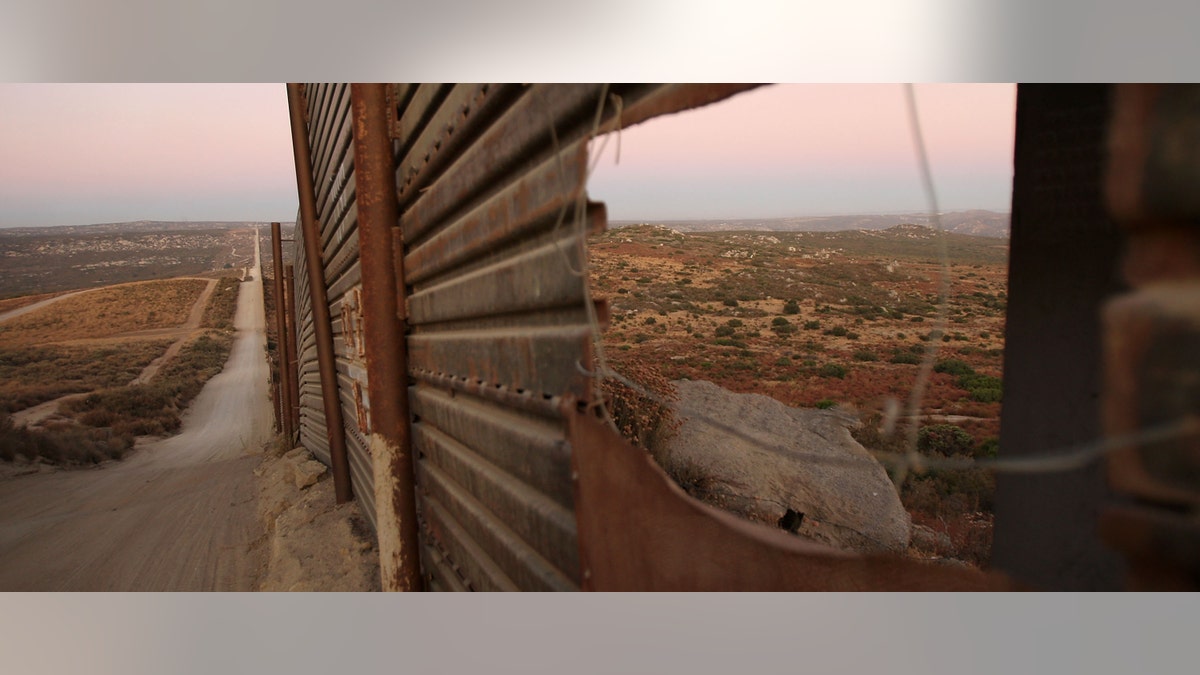
CAMPO, CA - JULY 29: A hole has been cut in the US-Mexico border fence where Border Patrol agents are carrying out special operations following the first fatal shooting of a US Border Patrol agent in more than a decade on July 29, 2009 near the rural town of Campo, some 60 miles east of San Diego, California. 30-year-old agent Robert Rosas was killed on July 23 when he tracked a suspicious group of people alone in remote brushy hills north of the border in this region. Violence has been escalating in Mexico with fights between well-armed drug cartels and the army becoming common since Mexican President Felipe Calderon began his army-backed war on the cartels. Since the conflict began in late 2006, 12,800 people have been killed. Mexican officials charge that guns which are easily smuggled in from the US have flooded into Mexico where gun laws are strict. (Photo by David McNew/Getty Images) (2009 Getty Images)
MEXICO CITY – As a priest in the town of Altar, near the Arizona border, the Rev. Prisciliano Pedraza sees migrants stocking up on supplies such as food, water and medicine for treacherous treks through the desert.
But he sees female migrants stocking up on something else: contraceptives, which they take preventatively to protect themselves against sexual violence all too common as they make the journey through Mexico to the United States.
“The women passing through here know that they’re going to be raped,” said Father Pedraza, director of a shelter for migrants in Altar.
“Migrants are a vulnerable group, and the most vulnerable among them are women.”
Thousands of Central Americans travel through Mexico every year attempting to reach the United States. But because they make the trip illegally, they are vulnerable to kidnappings, extortion and robbery – with organized criminal groups such as Los Zetas often acting in cahoots with law enforcement authorities.
In the case of women, the crimes include sexual assaults, forcing them to take precautions. They often take alternative routes through Mexico, feigning friendships with men in their group to stay safe while traveling. Increasingly, they are buying and consuming contraceptives before they make their trip.
“It’s on the increase,” says Marta Sánchez Soler, an advocate with the MesoAmerican Migrants Movement. “The first ones (doing it) were women from El Salvador, but now it’s everyone.”
Many contraceptives are sold without a prescription in Mexico, including the morning-after pill. Sánchez says some women receive injections before leaving or wear patches.
“They go to the pharmacy and buy emergency contraception for their trip to Mexico. This is they would tell us.”
Most church groups don’t supply the contraceptives – or condone what the women do, but they do help the women in other ways.
“They’re not giving it out, but they’re offering advice,” Sánchez said.
A network of shelters for migrants stretches the length of Mexico – with most run by Catholic priests and religious, who report being queried about contraceptives by women arriving as guests.
“They’ll arrive at the shelters and ask the priests or people that work there” about buying contraceptives, says Alberto Xicotencatl, director of the diocesan-run migrant shelter in Saltillo, 195 miles from the Texas border at Nuevo Laredo.
But women are less likely than men to stay at migrant shelters, which are often established near railway lines and frequented by Central Americans stealing rides on northbound trains known as “La Bestia,” or, “The Beast” – so named for the way it maims migrants who fall on the tracks and lose limbs.
Women attempt to avoid La Bestia, which organized crime now charges $100 to climb aboard, according to Xicotencatl. Criminal groups also prey on migrants while they wait in railway yards for trains to arrive.
“They would rather risk the immigration authorities than organized crime,” he says.
Women, unlike their male counterparts, often arrive in Mexico with more money from their families and hire human smugglers to take them north. In some situations, women will form a relationship with fellow migrants and pretend to be traveling as couples, Father Pedraza says.
Still, incidents of sexual assault are common. Father Pedraza puts the figure at 90 percent of all female migrants, but the number is impossible to know.
Father Alejandro Solalinde, operator of a shelter in the Istmo region of southern Oaxaca state, says the figure has dropped somewhat to perhaps 40 percent, due to increased enforcement in the southern state of Chiapas.
A 2011 survey by the National Public Health Institute at a shelter for migrants in the southern border city of Tapachula found 8.3 percent of women saying they had been raped, while 9.2 percent reported inappropriate touching. Some 28.2 percent said they traded sex for some sort of service or favor – such as northbound rides from truckers or bus drivers.
The Border Patrol arrested a man last year after a 14-year-old girl in Arizona reported she was raped by a “coyote,” or the person who smuggled her into the United States. And a Border Patrol agent, Esteban Manzanares, apparently killed himself after he was accused of kidnapping and raping three undocumented women in Texas.
Reliable statistics on border rapes do not exist, says Gretchen Kuhner, director of the Institute for Women in Migration (IMUMI) in Mexico, in part, because researchers inadvertently ask the wrong questions.
“When we did the interviews in the detention centers, women don’t even consider being pressured to have sex by the bus driver or truck driver … they don’t consider that sexual violence,” she says. “It’s really hard to ask women about that.”
Follow us on twitter.com/foxnewslatino
Like us at facebook.com/foxnewslatino




















